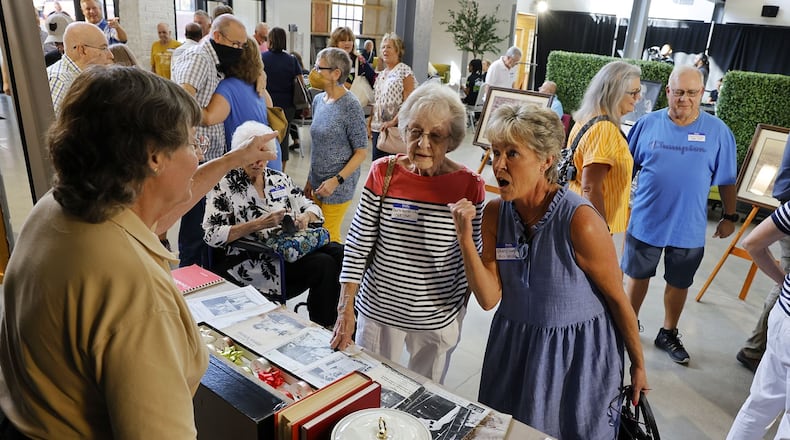His heartbreak was so severe that he and his wife, Martha, couldn’t drive past the shell of the former paper mill for 18 months after its closure.
“It tore me up,” he said.
When asked what was so special about the culture of Champion Mill, Mehl couldn’t put it into words. “You had to have been here,” he said.
Hundreds of former Champion Mill employees visited the renovated former plant that’s now the nearly completed $165 million, 1.2-million-square-foot redevelopment of the Spooky Nook at Champion Mill complex on North B Street that features a conference center, 233-room hotel, and a sports and events center.
Champion Mill operated the paper plant from 1893 to 2012 along the Great Miami River. Thousands of people, mostly from Hamilton and multiple generations of the some families, worked at the mill.
The former employees toured Mill 2, or No. 2 Mill as it was called during the plant’s operation, on Tuesday. Spots where some operated machines or sorted paper is now open space, a conference room or a hotel space. Though they didn’t see Mill 1, or No. 1 Mill as it was called, but that’s where things like basketball courts and a huge multipurpose room will now reside.
The former paper mill employees spent much of the two hours on Tuesday catching up with former colleagues, some of whom they see regularly, but others hadn’t seen their former colleagues in years.
Spooky Nook CFO Michael Dollard said they are “humbled to follow in the proud footsteps” of the Champion Mill. “Generations of hard-working people armed with grit and determination overcame incredible obstacles over several decades to create this historic international business, based in Hamilton,” he said.
Dollard said it was “incredibly important” for the company to show the former Champion employees what has become of the facility, which sat vacant for a few years before Sam Beiler came in with his team six years ago. He said the facility is being “returned to its former glory with a new purpose.”
“We are interested in learning their shared stories, experiences, and history so that we can better understand what happened before we arrived,” Dollard said. “We hope to share this legacy with the millions of visitors who will visit Champion Mill in the years to come.”
Though Mehl felt like family to his colleagues at Champion, for many of the employees, they were family.
Betty Crosby’s father, Gilbert Pyles, worked for a long time at the paper plant. Betty Crosby, who started on the back lines, came on board in 1949 and worked until she retired in 1992 where she worked on the first line. Her husband, Luke Crosby, came on a year after they were married, working from 1955 until his retirement in 1994.
And their son, Pat Crosby, worked at the mill from 1982 until leaving in 1995. He said it was hard to get a job at the paper mill decades ago.
“You had to know someone to get a job at Champion,” he said, adding it was that way at many of the manufacturing plants around the greater Hamilton area. “It was a good place to work.”
Betty Crosby’s role is forever etched in the history of Champion Mill. She was one of the paper sorters in Mill 1, or No. 1 Mill as it was called during Champion’s operations, and an image was captured of her during work. That image was etched on an ice bucket in 1982 and awarded to employees with perfect attendance.
A few of her family members received an ice bucket.
Tom Stanton worked here for 38 years, and only left when the plant closed. It was hard for Tom and his wife, Cindy, to drive past the shell of the former plant. They relied on the job, though they did, and still do, have rental properties.
Tom Stanton said the redevelopment is “impressive” as he looked around the convention center side of Mill 2. He worked mostly in shipping on the east side of the Great Miami River, but said he “worked in here a little bit. I help clean this place out.”
Cindy, who didn’t work at the mill but acknowledged “I feel like I did,” said, “I love the fact that somebody’s making something out of it.”
She’s 100% behind the project.
It’s been a decade since Tom Stanton walked into the Champion Mill facility, and he was asked if it was weird being back. As he stared around the development, picturing what used to be there compared to how it looks today, he shook his head and said, “Not really, not really.”
About the Author

